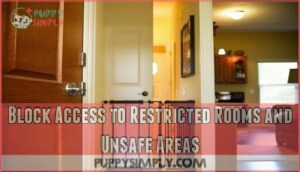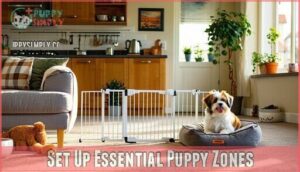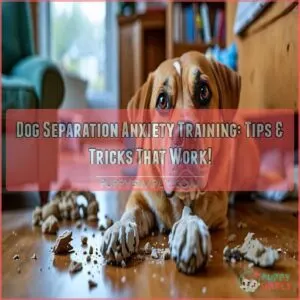This site is supported by our readers. We may earn a commission, at no cost to you, if you purchase through links.

The good news? You can prepare your home for a new puppy in a weekend if you know which hazards matter most. A few strategic changes transform your space from a minefield of puppy dangers into a safe environment where your new companion can thrive, and you’ll sleep soundly knowing those curious teeth aren’t headed for trouble.
Table Of Contents
- Key Takeaways
- Assess Your Lifestyle and Puppy Needs
- Puppy Proof Your Home for Safety
- Set Up Essential Puppy Zones
- Gather Supplies and Puppy Essentials
- Plan Training, Socialization, and Health Care
- Frequently Asked Questions (FAQs)
- How much exercise does my puppy need?
- What kind of food should I feed my puppy?
- How can I train my puppy not to bark excessively?
- What should I do if my puppy cries at night?
- How do I introduce my puppy to children and other pets?
- How do I choose the right puppy food?
- When can my puppy start going outside safely?
- How often should I bathe my new puppy?
- What should I do if my puppy cries?
- How long can puppies hold their bladder?
- Conclusion
Key Takeaways
- Preventable accidents like electrical cord injuries, toxic ingestions, and swallowed objects top first-week puppy disasters, but a focused weekend of preparation—securing cords, removing hazards, and setting up safe zones—transforms your home from dangerous to puppy-ready.
- Upfront costs range from $1,150 to $4,420, with ongoing monthly expenses for food, vet care, and emergencies, so budget planning and securing local veterinary services before your puppy arrives are non-negotiable parts of responsible ownership.
- Establishing dedicated puppy zones with a properly sized crate, easy-to-clean bedding, and organized feeding stations creates structure that makes housetraining, supervision, and behavioral development significantly easier from day one.
- Early socialization through controlled introductions, puppy classes (enrolled by 49% of owners within five months), and a consistent daily routine of feeding, exercise, and training build confidence and prevent fear-based behavioral issues that are harder to fix later.
Assess Your Lifestyle and Puppy Needs
Before you bring home that bundle of puppy energy, you need to take a hard look at your own life and what a dog truly requires. The right match between puppy and household isn’t about falling for the cutest face—it’s about understanding breed characteristics, your daily schedule, and the financial commitment you’re signing up for.
Let’s walk through the key factors that’ll help you make a smart, informed choice.
Research Suitable Puppy Breeds
Choosing the right puppy starts with understanding breed characteristics and how they match your household. Not every dog breed thrives in every setting, so researching puppy temperament, health considerations, and breed compatibility matters before you commit.
- Labrador Retrievers pass temperament tests at 92.2% and adapt well to families with children
- French Bulldogs topped AKC rankings for three consecutive years ending in 2024
- Bichon Frise and Shih Tzu suit apartments, with 67% of city-based new owners choosing small breeds
- Goldendoodles and Labradoodles saw a 34% registration increase from 2020 to 2025
- Cavalier King Charles Spaniels appear in nine of ten expert recommendations for first-time owners
When selecting a breed, consider evaluating the family friendly breeds to ensure a smooth adjustment for your household.
Consider Your Living Situation and Activity Level
After you’ve identified a breed that matches your family’s temperament, you’ll need to assess whether your home and daily routine can realistically support that puppy’s energy and space requirements. A high-energy Border Collie won’t thrive in a cramped apartment without outdoor access, while neighborhood safety and daily schedules shape how much exercise time you can commit to.
Space management and family dynamics determine household petproofing needs, so evaluate your dogfriendly home honestly before preparing for a new puppy.
Budget for Upfront and Ongoing Expenses
Once you’ve confirmed your space and schedule work for your chosen breed, you’ll need to face the financial reality—upfront costs for a puppy range from $1,150 to $4,420 in the USA, and that’s before you factor in monthly expenses like food, vet visits, and emergency funds.
Bringing home a puppy costs $1,150 to $4,420 upfront—before monthly expenses like food, vet bills, and emergencies even start
Budget planning means accounting for initial costs like crates and bowls, ongoing veterinary fees, and setting aside money for unexpected medical issues, because responsible pet ownership requires financial preparation as much as emotional readiness.
Identify Local Veterinarians and Their Services
Budgeting also means securing veterinary care before your puppy arrives, which starts with researching local vet clinic services and reading reviews to find a practice that manages routine puppy health needs plus emergency care if things go sideways. Here’s what to check:
- Annual exams and vaccination schedules offered at general practices
- Dental care and parasite prevention services available nearby
- Access to veterinary specialists for cardiology or neurology if needed
- Emergency care hours and telemedicine options for after-hours advice
Most urban areas have strong veterinarian-to-pet ratios, but rural communities face shortages, so confirm availability early and ask about pet insurance options that cover preventive dog health visits. Regular veterinary services are vital for maintaining pet health, and learning about common veterinary care can help you make informed decisions.
Puppy Proof Your Home for Safety
Puppies explore the world with their mouths, and that means your home needs a serious safety audit before they arrive. You’ll want to identify and eliminate hazards room by room, focusing on anything a curious pup could chew, swallow, or knock over.
Here’s how to tackle the most critical safety measures that protect your new companion from common household dangers.
Remove Toxic Substances and Hazardous Items
Puppies are curious explorers with zero sense of danger, which means your home is basically a buffet of things they shouldn’t eat, chew, or knock over. Start with toxic substance removal—lock away medications, cleaning products, and antifreeze in high cabinets.
For household safety, move houseplants like lilies and philodendrons out of reach, since many common varieties are poisonous. Hazardous item storage extends to small objects like coins, batteries, and string that puppies love but can cause serious internal damage.
Pet-safe cleaning products should replace harsh chemicals to prevent accidental poisoning during your puppy-proofing routine.
Secure Electrical Cords, Outlets, and Trash Cans
Electrical cords dangling within reach are like chew toys that bite back, so securing them is non-negotiable in a puppy-safe home. Dog safety at home means treating puppy safety like toddler-proofing—assume everything’s a target.
Here’s your electrical safety and puppyproofing checklist:
- Cord protectors shield exposed wires from curious mouths
- Outlet covers prevent shock from exploratory nosing
- Trash can locks stop access to spoiled food and hazards
- Run cords behind furniture or use cable management systems
- 92% of pet proofing households secure electrical risks first
Block Access to Restricted Rooms and Unsafe Areas
Think of your home as a series of invisible boundaries—some rooms are safe havens for exploration, while others hide dangers a curious puppy can’t yet understand. Establishing access restriction early sets the foundation for household safety and effective puppy proofing.
| Room Type | Primary Hazards | Puppy Proofing Method |
|---|---|---|
| Bathroom | Medications, cleaning products, toilet water | Close doors, secure cabinets |
| Kitchen | Hot surfaces, sharp objects, food toxins | Baby gate installation at entries |
| Home Office | Cables, small items, chemicals | Room blocking with closed doors |
| Garage/Basement | Antifreeze, tools, pesticides | Secure entry points, locked access |
Close doors to hazard-prone spaces or use barriers to maintain dog safety throughout your puppy proofing and safety plan.
Install Baby Gates and Anti-tipping Kits
After you’ve blocked off the danger zones, it’s time to add the physical barriers that turn good intentions into fail-safe boundaries—baby gates and anti-tipping kits work like insurance policies your puppy can’t chew through.
- Install pressure-mounted gates at stairways and room entries to control access without drilling holes, making gate installation reversible and rental-friendly
- Anchor tall furniture with anti-tipping kits—68% of pet-ready homes use these secure furniture tips to prevent toppling bookcases and dressers during puppy exploration
- Choose gates with vertical slats instead of horizontal bars to prevent climbing injuries as part of your accident prevention strategies
- Test stability daily during the first week of new puppy care to verify your pet safety measures stay effective as your puppy grows stronger
Set Up Essential Puppy Zones
Once you’ve puppy-proofed your home, it’s time to set up the spaces where your new companion will eat, sleep, and play. These designated zones give your puppy a sense of security while making house training and supervision much easier.
Let’s walk through the key areas you’ll need to establish before bringing your puppy home.
Create a Safe Puppy Room or Contained Area
Setting up a dedicated space where your puppy can explore, rest, and stay out of trouble is one of the smartest moves you’ll make before bringing them home. Choose a quiet room or corner where you can control what your puppy encounters—think kitchen, laundry room, or spare bedroom.
This puppy room should have easy-to-clean flooring, no exposed wires, and nothing within chewing distance that you’d rather keep intact. Secure enclosures like baby gates help define boundaries while letting your pup feel connected to household activity.
Choose and Set Up a Crate and Playpen
A crate isn’t a cage—it’s your puppy’s personal den, a safe haven where they can decompress, sleep soundly, and learn the self-control that makes housetraining so much easier. When selecting a dog crate, measure your pup’s expected adult size—enough room to stand, turn, and stretch, but not so spacious they’ll designate a corner as a bathroom. Pair it with a playpen to expand their safe play area during supervised time.
Crate setup essentials:
- Crate placement near family activity helps reduce separation anxiety
- Soft bedding inside creates comfort for rest and crate training
- Playpen safety requires secure latches and no sharp edges
- Puppy enclosures should include water access and age-appropriate toys
Prepare Easy-to-clean Bedding and Mats
Puppies are adorable, messy roommates—accidents happen, and you’ll want bedding that can be thrown in the wash without a second thought. Choose fabric safety first—look for puppy cushions with removable, washable covers that resist chewing and won’t fray into choking hazards. Puppy mats protect floors during early housetraining, and mat cleaning becomes straightforward when materials are waterproof-backed.
| Bedding Materials | Puppy Care and Maintenance |
|---|---|
| Washable fleece or cotton covers | Machine wash weekly, air dry |
| Waterproof-backed puppy mats | Wipe daily with pet-safe cleaning supplies |
| Low-fill puppy bed cushions | Replace if torn or heavily soiled |
Organize Feeding, Water, and Hygiene Stations
Once your puppy’s sleep zone is sorted, you’ll need to set up a feeding and hygiene corner that keeps meals mess-free and makes clean-up a breeze. Position food and water bowls on a washable mat, away from high-traffic areas, to create a calm food station setup. Keep hygiene equipment—toothbrush, dog-safe toothpaste, and shampoo—stored nearby for quick access.
Puppy grooming essentials and feeding schedule management become simpler when everything’s organized:
- Place water bowls where your puppy can reach them throughout the day
- Store puppy food in airtight containers to maintain freshness
- Keep hygiene product selection minimal but effective for puppy health and hygiene needs
Gather Supplies and Puppy Essentials
Before your puppy arrives, you’ll need to stock up on the right gear to keep them safe, healthy, and comfortable from day one. Having these essentials ready means you won’t be scrambling to the pet store when you should be bonding with your new companion.
Let’s walk through the must-have supplies every puppy owner needs to gather before bringing their furry friend home.
Select Appropriate Chew Toys and Safe Treats
Chew toys aren’t just entertainment—they’re your puppy’s best defense against turning your furniture into kindling. Look for durable toys made from non-toxic rubber or nylon, and always match size to your pup’s age.
Kong toys and snuffle mats redirect destructive behavior while satisfying natural chewing instincts.
For safe chews like rawhide or pig’s ears, supervise closely—they’re treats, not babysitters.
Purchase Bowls, Leash, Collar, and ID Tags
Beyond toys and treats, your puppy needs the right gear to stay safe, fed, and connected to you—starting with sturdy bowls, a leash that won’t snap mid-walk, and ID tags that could save their life.
Choose stainless steel or ceramic bowls for bowl hygiene—plastic harbors bacteria. A 4-to-6-foot leash aids leash training, while a properly fitted collar with ID tag tips like your phone number ensures collar safety.
These puppy accessories form your puppy essentials checklist, grounding your puppy ownership and lifestyle in practical puppy home preparation.
Prepare a Puppy First-aid and Health Record Kit
Emergencies don’t wait for business hours, so stocking a puppy first-aid kit and organizing health records now means you’ll respond with confidence, not panic, when your pup needs help fast. Include gauze, tweezers, and emergency contacts for after-hours veterinary care and advice.
Keep vaccination records, medical history, and puppy health insurance details in a waterproof folder—you’ll need them for canine health tracking and puppy development and growth check-ins, ensuring uninterrupted puppy health and wellness from day one.
Plan Training, Socialization, and Health Care
Once you’ve puppy-proofed your space and gathered the right gear, the next step is setting your puppy up for long-term success through proper health care, training, and social exposure. These early weeks shape your dog’s behavior, confidence, and well-being for years to come.
Here’s how to tackle the essentials, from that vital first vet visit to building a daily routine that works for both of you.
Schedule First Vet Visit and Vaccinations
Your puppy’s first veterinary visit isn’t just a checkup—it’s the foundation for a lifetime of health. You’ll want to schedule it within the first few days of bringing your new companion home.
During this initial vet visit, your veterinarian will perform thorough health checks, discuss shot schedules for puppy vaccines including distemper and parvovirus, review medical costs, and provide veterinary care and advice customized to your new puppy’s wellness needs.
Begin Basic Training and Crate Routines
Training starts the moment your puppy walks through the door, and establishing a consistent crate routine now will save you countless headaches down the road. Start with basic commands like "come" and "stay" using positive reinforcement—think treats and praise, not punishment.
Crate training makes housebreaking tips easier to implement while giving your puppy a safe den for puppy development.
Practice leash manners early, keeping sessions short and rewarding good puppy obedience to build confidence and prevent future behavioral issues.
Introduce Puppy to People and Pets Gradually
Think of socialization like building immunity—early, controlled exposure protects your puppy from developing fear and aggression later, but overwhelming them too fast can backfire just as badly as skipping this step entirely.
Limit initial puppy introduction to calm, friendly people and well-mannered pets, keeping interactions short and positive. Watch your puppy’s body language during pet interactions—if they retreat or freeze, scale back immediately.
Gradual introduction respects family dynamics while supporting healthy behavioral adjustment through responsible pet care and thoughtful puppy socialization.
Enroll in Puppy Socialization Classes
Socialization classes—where structured puppy interactions meet canine behavior expertise—offer controlled environments that home introductions can’t replicate. Around 49% of puppy owners enroll within five months, and for good reason: these classes teach social learning through supervised puppy training and exposure to diverse dogs, people, and stimuli.
Choose class schedules that match your puppy’s vaccination timeline, usually starting around 8–10 weeks, and look for trainers using positive training methods that build confidence without overwhelm.
Establish a Daily Care and Exercise Routine
Consistency—not intensity—forms the foundation of healthy puppy development, and a predictable daily routine anchors everything from housetraining success to emotional security.
Set fixed feeding times (usually three to four meals for young pups) and schedule short play activities after meals to support dog nutrition and diet while preventing accidents.
Balance puppy exercise with age-appropriate rest—puppies need mental stimulation through puppy training sessions and physical activity, but overexertion can harm growing joints, so keep walks brief and playful.
Frequently Asked Questions (FAQs)
How much exercise does my puppy need?
Most puppies need just five minutes of exercise per month of age, twice daily—so a three-month-old gets about fifteen minutes per walk.
Short playtime activities and gentle energy release methods support healthy puppy development without overtaxing growing joints.
What kind of food should I feed my puppy?
Choose a complete, high-quality puppy food formulated for growth, ensuring it meets AAFCO standards for canine nutrition and diet.
Feed age-appropriate portions three to four times daily, shifting gradually from your breeder’s recommended diet.
How can I train my puppy not to bark excessively?
Excessive barking often signals boredom, fear, or attention-seeking, so redirect this dog behavior by teaching quiet commands paired with reward training.
Use calming techniques and crate training to manage triggers, and guarantee adequate puppy obedience through consistent puppy training and socialization.
What should I do if my puppy cries at night?
When your puppy cries at night, place their crate near your bedroom so they feel secure.
Try calming techniques like a ticking clock or warm blanket, and avoid reinforcing whining with immediate attention—sleep training requires patience.
How do I introduce my puppy to children and other pets?
Gradual introductions are key to household dynamics and pet harmony. Let children sit quietly while your puppy approaches on their terms, teaching gentle touch and calm voices.
For other pets, use controlled meetings through baby gates first, then brief supervised sessions, rewarding calm behavior to build positive associations and safe puppy socialization.
How do I choose the right puppy food?
A puppy’s stomach is smaller than your fist, making nutrient balance critical. Look for AAFCO-approved puppy food formulated for growth, with quality protein as the first ingredient.
Monitor for food allergies, adjust feeding schedules as they grow, and consult your vet about breed-specific dietary needs.
When can my puppy start going outside safely?
Your puppy can venture outside for brief, controlled walks roughly two weeks after completing their core vaccination schedule, usually around 16-18 weeks old.
Until then, prioritize puppy socialization through safe indoor exposures and carry outings to minimize outdoor hazards and parasite control risks while building immunity.
How often should I bathe my new puppy?
Most puppies need baths only once every 4–6 weeks to protect skin health and their natural coat oils.
Bathing too often strips essential moisture, risking dryness and irritation, so stick to dog-specific shampoo and a gentle grooming routine.
What should I do if my puppy cries?
Soft sounds and steady comfort calm puppy distress quickly. Address crying causes first—loneliness, hunger, or needing to potty.
Use calming methods like gentle touch, warm bedding, or a ticking clock near their puppy home to ease anxiety and build trust.
How long can puppies hold their bladder?
As a general rule, puppies can hold their bladder for roughly one hour per month of age, so a two-month-old pup needs a bathroom break every two hours to prevent accidents and support successful housebreaking and crate training.
Conclusion
Last week, a puppy hospitalized for eating drywall cost his family $3,200—this week, you’re spending $50 on baby gates and saving yourself that nightmare.
When you prepare your home for a new puppy with intention, you’re not just moving furniture around; you’re building a foundation where accidents don’t happen and trust does. Your puppy arrives with no idea what’s dangerous, so you become the one who thinks three steps ahead—securing cords, locking cabinets, creating safe zones.
That weekend of preparation isn’t overthinking; it’s the difference between emergencies and peace of mind.













